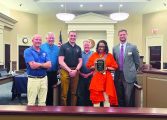By Heather Michon
Correspondent
The Board of Supervisors got its first look at potential new voting districts during a redistricting work session ahead of its regular meeting on Wednesday (Oct. 20).
County Administrator Eric Dahl presented a series of maps showing the county split into five, six, and seven districts, based on the newly-released 2020 Census numbers.
Under Virginia law, localities must redistrict every decade in the year following the national census.
While redistricting can be a complex process, the general guidelines are straightforward: districts have to be about equal in population size, they have to be geographically compact, they have to be contiguous, and they have to avoid any sort of racial or other demographic bias.
Supervisors are also prohibited from splitting census blocks, a geographic unit defined by the Census Bureau.
Assistant County Administrator Kelly Belanger Harris said Fluvanna had fewer census blocks in 2020 than in the previous census. Supervisor Tony O’Brien (Rivanna), who sits on the redistricting committee, noted that this provides an additional challenge, as the population within each census block can vary quite a bit in size, “with some being 600 and some being eight.”
[pdf-embedder url=”https://fluvannareview.com/wp-content/uploads/2021/10/5_districts1.pdf”]
[pdf-embedder url=”https://fluvannareview.com/wp-content/uploads/2021/10/7_districts2.pdf”]
GROWTH TO THE WEST
The census numbers show that Fluvanna’s population has grown primarily along the western half of the county. O’Brien said “45 percent of the county [population is] concentrated within about two miles of the Lake.”
According to adjusted census numbers from the Virginia Department of Legislative Services, Palmyra gained 885 residents and Cunningham grew by 403, while Columbia lost 971 residents and Fork Union lost 197. Rivanna, which encompasses much of Lake Monticello, added only 71 residents.
To keep at the current level of five districts, Palmyra and Cunningham would have to shed some population, and Columbia and Fork Union would have to gain some. Each district would have approximately 5,285 residents.
Dahl presented two scenarios, each showing the boundaries of Fork Union and Columbia pushing west into the developments that have grown around Lake Monticello.
He also introduced a map showing the county split into six districts of roughly 4,381 residents. Here, the borders of Fork Union and Columbia would shift less dramatically, but the western end of Lake Monticello and the growing developments on that side of the county would split into a new district.
Finally, he showed two different scenarios for a seven-district county, with each district containing around 3,756 residents.
One idea is to create two districts around Lake Monticello, one along the south side of the lake down to Rt. 53 between South Boston Road and Nahor Manor Road, and a second hugging the north side of the lake from South Boston Road to the western border of the county, and extend along one side of Mechunk Creek north almost as far as I-64.
The second map envisions the Lake split into two districts above and below Jackson Cove, and also creating a large V-shaped district between the current Palmyra and Columbia districts, ending at Central Plains Road.
O’Brien said he felt this was the scenario that would work best for the long-term growth of the county population, as development was clearly going to remain concentrated on the western side of Rt. 15 over the next 10 to 20 years.
EQUAL REPRESENTATION
During the discussions about the merits of each scenario, some of the emotional and practical issues that surround redistricting came to the forefront.
Chair Mike Sheridan (Columbia) stressed that he wasn’t trying ot make it “us and them,” but especially in the five-district scenarios, the 45 percent of residents who live in the population center in and around Lake Monticello would be represented by 80 percent of the supervisors.
At five districts, there is no way for Columbia and Fork Union to reach 5,258 residents unless they absorb some of that western population.
But with that sort of over-representation, “you could end up with somebody representing the entire east side of the county that has never been to the east side of the county,” he said. “I just want to make sure that each voice is heard equally.”
No matter what the final map looks like, voting locations are likely to move for many Fluvanna residents.
O’Brien said that this was perhaps the biggest complaint following the previous redistricting in 2010. “The more you move people around, the more it frustrates folks from that standpoint. It’s just human nature,” he said.
LEGAL RAMIFICATIONS
County Attorney Fred Payne also weighed in with his perspective on the ramifications of expanding the number of districts.
In his opinion, a five-district scenario “will be easier to administer and less inclined to have somebody challenged if somebody wants to challenge. It’s also less costly to the county.”
Adding one to two seats would require a special election and two more annual salaries to the county budget. The School Board and the Social Services Board would also have to add additional seats, and Supervisors would have to decide if they wanted to expand the Planning Commission.
“I guess I’m just a simple-minded kind of guy,” said Payne. “It’s easier to have a simple solution than a more sophisticated one. I’m not saying you can’t do it or you shouldn’t do it, but that’s the way I view the pros and cons.”
NEXT STEPS
Wednesday’s work sessions as just one more step in a process that will continue for the next several weeks.
Plans are underway to hold one or more community meetings to introduce the different plans to residents.
The preliminary maps are available for viewing online at http://www.fluvannacounty.org To keep informed on upcoming redistricting meetings, be sure to sign up for the county’s electronic newsletter, FAN Mail.




